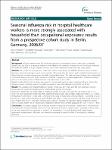Seasonal influenza risk in hospital healthcare workers is more strongly associated with household than occupational exposures: results from a prospective cohort study in Berlin, Germany, 2006/07
Williams, Christopher J.
Schweiger, Brunhilde
Gerlach, Frank
Haaman, Frank
Krause, Gérard
Nienhaus, Albert
Buchholz, Udo
Diner, Genia
Background: Influenza immunisation for healthcare workers is encouraged to protect their often vulnerable patients but also due to a perceived higher risk for influenza. We aimed to compare the risk of influenza infection in healthcare workers in acute hospital care with that in non-healthcare workers over the same season. Methods: We conducted a prospective, multicentre cohort study during the 2006/07 influenza season in Berlin, Germany. Recruited participants gave serum samples before and after the season, and completed questionnaires to determine their relevant exposures and possible confounding factors. The main outcome measure was serologically confirmed influenza infection (SCII), defined as a fourfold or greater rise in haemagglutination inhibition antibody titres to a circulating strain of influenza (with post-season titre at least 1:40). Weekly mobile phone text messages were used to prompt participants to report respiratory illnesses during the influenza season. A logistic regression model was used to assess the influence of potential risk factors. Results: We recruited 250 hospital healthcare workers (mean age 35.7 years) and 486 non-healthcare workers (mean age 39.2 years) from administrative centres, blood donors and colleges. Overall SCII attack rate was 10.6%. Being a healthcare worker was not a risk factor for SCII (relative risk 1.1, p=0.70). The final multivariate model had three significant factors: living with children (odds ratio [OR] 3.7, p=0.005), immunization (OR 0.50, p=0.02), and - among persons living in households without children - ownership of a car (OR 3.0, p=0.02). Living with three or more children (OR 13.8, p
Dateien zu dieser Publikation
Keine Lizenzangabe

